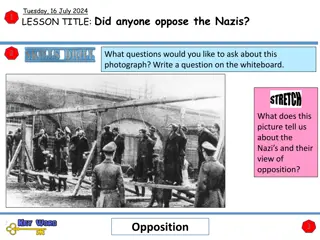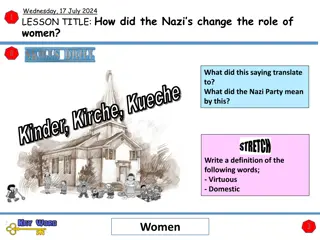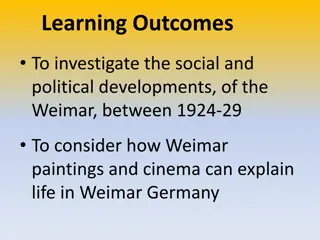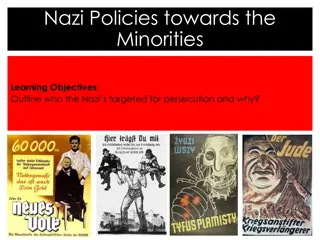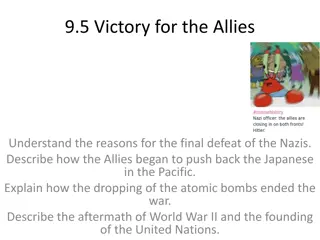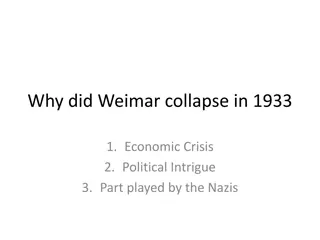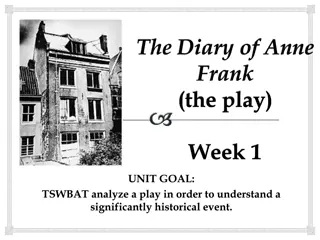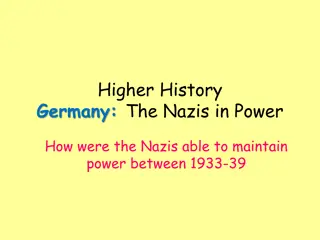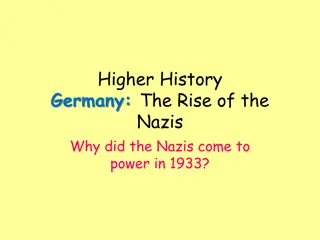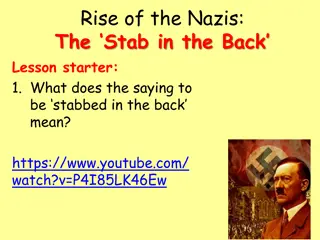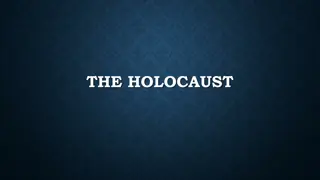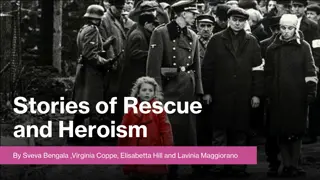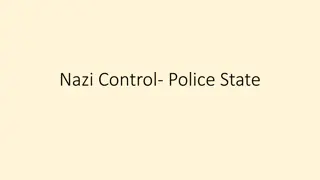Opposition to Nazis: Youth Groups and Resistance Movements
Explore various forms of opposition to the Nazis through youth groups like the Swing Youth and Edelweiss Pirates. Learn about their defiance against the Nazi regime, including activities and methods of resistance. Discover the diversity of opposition movements and their impact on Nazi Germany's cont
0 views • 10 slides
Women's Role in Nazi Germany: Impact and Ideology
Explore how the Nazis shaped the role of women through policies and propaganda, emphasizing domesticity and motherhood. Analyze key figures like Joseph Goebbels and Hitler's perspectives on women's place in society. Understand the contrast between women's lives in Weimar and Nazi Germany.
0 views • 18 slides
Social and Political Developments in Weimar Germany (1924-1929)
The period between 1924 and 1929 in Weimar Germany witnessed greater political stability with the Social Democrats winning most of the votes, although they did not secure a majority. The election results show a decline in support for extremist groups like the Communists and Nazis. Factors contributi
1 views • 29 slides
Nazi Persecution of Minorities: Targets and Rationale
The Nazis targeted various groups for persecution, believing in a racial hierarchy where certain races were deemed inferior. They aimed to eliminate those they considered undesirable, including Gypsies, black people, the mentally disabled, homosexuals, and more. The Nazis' actions were driven by the
7 views • 12 slides
Victory in World War II: Defeat of Nazis, Pacific Campaigns, Atomic Bombs, and Aftermath
Allies achieved final victory over the Nazis in Europe through coordinated offensives and pivotal factors like US productivity and Luftwaffe shortages. After the defeat of Germany, attention turned to pushing back the Japanese in the Pacific through intense battles and the eventual dropping of atomi
0 views • 13 slides
Struggle and Hope: A Tale of Survival During Unimaginable Times
Moshe, a devoted scholar, witnesses the horrors of the Holocaust and tries to warn fellow Jews in Sighet, who initially dismiss his warnings. As their village is taken over by the Nazis, they face ghettos and brutality, testing their resilience and hope for liberation amidst unimaginable suffering a
0 views • 37 slides
Factors Leading to the Collapse of the Weimar Republic in 1933
Economic crisis, political intrigue, and the rise of the Nazis were key factors in the collapse of the Weimar Republic in 1933. The Wall Street Crash of 1929 exacerbated Germany's economic problems, leading to massive unemployment and social unrest. Political errors and the erosion of democracy furt
0 views • 15 slides
Understanding the Historical Context of "The Diary of Anne Frank
The play "The Diary of Anne Frank" is based on the true story of a young Jewish girl named Anne Frank during the Holocaust in World War II. Through analyzing the play, students explore the significant historical event of the Holocaust, where millions of Jews were systematically persecuted and killed
0 views • 13 slides
The Nazis' Consolidation of Power in Germany, 1933-1939
In the period between 1933 and 1939, the Nazis under Hitler orchestrated a series of strategies to maintain power in Germany. This included the establishment of a totalitarian state, implementation of social controls, extensive propaganda campaigns, foreign policy decisions, and economic measures. H
0 views • 38 slides
Understanding the Rise of the Nazis in 1933: Factors and Impacts
Explore the reasons behind the Nazis' ascent to power in 1933, covering political weaknesses of the Weimar government, economic challenges, the appeal of the Nazis, and the lack of unified opposition. Unpack the historical context of post-World War I Germany and the factors that contributed to Hitle
0 views • 38 slides
Understanding the Actions of German Holocaust Perpetrators
Christopher Browning's research focuses on Police Battalion 101, revealing they were ordinary German men, not dedicated Nazis. These men were primarily middle-aged, working-class individuals who participated in the Józefów massacre during World War II. Browning's analysis delves into the motivatio
0 views • 7 slides
The Stab in the Back Theory: Rise of the Nazis After WWI
The Stab in the Back Theory originated in Germany post-WWI, where people felt betrayed by politicians and generals for surrendering prematurely. Hitler used this theory to blame Socialists, Communists, and Jews, gaining followers by offering someone to blame for Germany's defeat.
0 views • 8 slides
Understanding the Holocaust: History and Impact
The Holocaust was a horrific genocide orchestrated by Nazis and their collaborators with the aim of annihilating the Jewish people. It involved systematic mass murder, displacements, and destruction of lives during World War II. Anti-Semitism, World War I, and World War II were key factors leading t
0 views • 25 slides
Inspiring Stories of Rescue and Heroism During the Holocaust
Franceska Mann, a talented young ballerina of Jewish heritage, displayed immense courage and heroism during the Holocaust. Despite facing deportation to Auschwitz, she bravely fought against the Nazis, inspiring others to resist. Alongside other heroic individuals like Iranian diplomat Abdol Hossein
0 views • 12 slides
Remembering the Holocaust: Auschwitz Liberation and Holocaust Memorial Day
The 27th of January marks Holocaust Memorial Day, commemorating the liberation of Auschwitz by Russian soldiers. This day serves as a reminder of the atrocities of the Holocaust, where six million Jews were murdered by Hitler and the Nazis during World War II. The Holocaust Memorial Trust emphasizes
0 views • 11 slides
Nazi Control in Germany: The Dark Reign of the Police State
The Nazis implemented a strict regime of control in Germany through censorship, propaganda, and the establishment of a powerful police state. They used organizations like the SS, Gestapo, and SD to suppress dissent, monitor the population, and silence opposition. The legal system was manipulated to
0 views • 8 slides
Exploring Characters and Themes in Post-WWI Germany
Delve into the intricacies of characters like Rudy Steiner and Hans Huberman in the backdrop of post-World War I Germany under the influence of Hitler and the Nazis. Analyze direct and indirect characterizations, discuss the impact of historical events on families like Rudy's, and compare characters
0 views • 10 slides
Overview of Nazi Propaganda and Control Methods
The content discusses different types of Nazi propaganda, the reasons behind Kristallnacht, and the effectiveness of terror as a control method by the Nazis. It highlights how propaganda, violence, and fear were utilized to manipulate and suppress the German population during the Nazi regime.
0 views • 8 slides
Winston Churchill - British Statesman and Prime Minister
Winston Churchill, a prominent figure in British and American history, served as Prime Minister of the United Kingdom during World War II and again from 1951 to 1955. Known for his refusal to surrender to the Nazis, Churchill was a statesman, army officer, historical writer, journalist, artist, and
0 views • 14 slides
